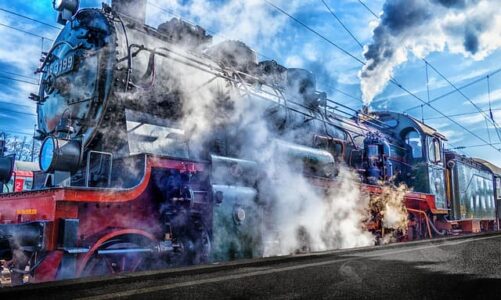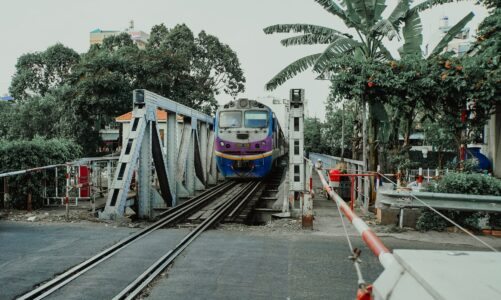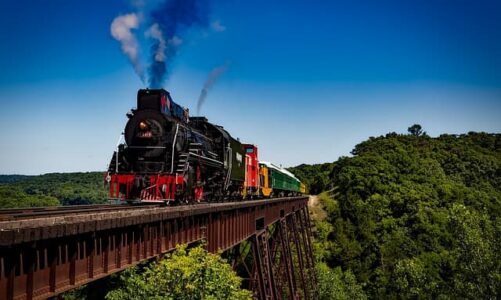Rail transport is undergoing significant changes in response to the growing demand for fast transportation between cities and countries. Major trends in the rail industry involve drones and intelligent sensors for track inspection, digital communication platforms and automatic train control. For train operators and railroad companies, Internet of Things (IoT) devices enable preventive maintenance to track any anomalies.
Autonomous trains.
The autonomous train is an effective solution for improving punctuality, reliability and capacity optimization in the rail industry. Modernization of signaling technology and automatic train control systems reduces technical errors, improves the flow of traffic information, and increases passenger confidence in rail transportation. For example, a system with automation level 4 (GoA4) autonomously handles emergencies and detects obstacles as well as monitors train speed, brakes and doors.
OTIV – ADAS for light rail
Belgian startup OTIV develops advanced driver assistance systems (ADAS) and full autonomous driving solutions (FSD) for light rail and shunting applications. The startup uses artificial intelligence (AI), deep learning, and computer vision.
ADAS and FSD systems, equipped with object detection and collision avoidance technologies, further improve the safety and efficiency of rail transport.
GEAR International Holdings – integrated signaling
South African startup GEAR International Holdings offers integrated railway signaling solutions. The system uses train location information for interlocking and provides communication-based train control.
Internet of Things
The Internet of Things greatly affects the reliability and safety of rail infrastructure. Condition-based monitoring prevents delays caused by broken tracks and train parts, which optimizes efficiency and maintenance costs, and improves passenger satisfaction. In addition, advanced IoT-enabled analytics allow rail operators to find data-driven solutions to improve fleet management and increase the efficiency of rail operations.
TRAINFO – Railway Crossing Monitoring
Canadian startup TRAINFO offers a cost-effective solution that helps reduce traffic delays at railroad crossings. The startup uses train sensors, Bluetooth, and predictive software to determine when to open and close railroad crossings. This information is then relayed to drivers through information systems such as roadside signs, mobile apps or traffic signals. The startup’s solution also helps city governments design and operate railroad crossings and other infrastructure.
HUM Industrial Technology – Predictive monitoring and fleet tracking
U.S. startup HUM Industrial Technology offers predictive monitoring solutions to rail shippers and car owners. The startup uses wireless IoT sensors to automatically monitor safety and predict wheel and bearing failures, and to detect oil or gas leaks. The startup also provides a real-time global positioning system (GPS) tracking solution that offers a comprehensive overview of a fleet’s location and history. The startup helps railroad operators reduce maintenance costs by enabling early detection of potential failures.
Artificial Intelligence.
AI finds many applications in the rail industry, including asset management, preventive maintenance, and emergency alerting. Deep learning algorithms and neural networks help optimize train schedules and minimize delays. In addition, advanced passenger information systems improve transportation services and increase passenger satisfaction.
Train Brain – AI traffic planning and control
Swedish startup The Train Brain develops artificial intelligence models that improve the reliability of public transport. The startup’s tool provides delay forecasting, as well as real-time traffic modeling and reporting. The tool processes train schedules and signaling or global positioning system (GPS) data to predict the train network. Train Brain allows rail operators to make data-driven traffic planning decisions, and passengers get more information when planning their commute to and from work.
Cedar AI – Train Station Operations
U.S. startup Cedar AI offers artificial intelligence-based solutions to help rail operators improve the efficiency of marshalling station operations. The startup’s artificial intelligence-based platform integrates with existing software to enforce safety rules during train station operations. The platform helps railroad operators optimize warehouse processes and reduce workload and improve train safety.
Decarbonizing
Although railroads are the most sustainable mode of transportation, in line with ambitious zero-emissions plans, governments are seeking to further decarbonize the rail industry. The most common decarbonization solutions include replacing diesel trains with battery technology, hydrogen fuel cells, or electric trains. To further minimize CO2 emissions railway operators use electric locomotives powered by renewable sources of energy, such as solar energy or wind.
Core Environmental Systems – battery power solutions
Australian startup Core Environmental Systems offers energy storage solutions to the public and end users in a variety of industries, including railroads. The startup’s Enviro Cell-Rail , designed specifically for the needs of the railroad industry, solves the power shortage of traditional batteries. In doing so, the startup reduces and sometimes eliminates monetary losses for rail operators while improving the efficiency of rail transportation.
Hoeller Electrolyzer – Electrolysis Batteries for Hydrogen
U.S.-based startup Hoeller Electrolyzer supplies polymer electrolyte membrane (PEM) electrolysis stacks for manufacturers of environmentally friendly hydrogen systems. The startup offers its Prometheus electrolysis stacks to optimize hydrogen fuel cell storage capabilities in electric and hybrid locomotives. This optimization increases the maximum performance of PEM electrolysis as well as reduces the cost of green hydrogen storage.
Rail Mobility
Modern rail mobile communication systems, augmented with 5G technologies, provide low-latency communication and high performance as well as reliable rail infrastructure. In addition, connectivity-based train control (CBTC) provides efficient rail traffic management and asset monitoring. Train connectivity applications cover train positioning, control, maintenance, passenger service and passenger data collection.
Tethir – ground-to-car connectivity
British startup Tethir is developing optoelectronic ground-to-vehicle communications devices for connecting trains and autonomous vehicles. The startup’s devices provide high throughput with low power consumption. The solar-powered devices create a wide field of view for better communication.
Passengers – On-Board Communications.
Czech startup Passengera is developing a platform that provides Wi-Fi connectivity and an infotainment system for train passengers. The startup’s connectivity solution gives passengers access to in-flight entertainment, news, and travel and accommodation information via smart devices or laptops. In addition, the startup’s connected solutions support passenger information and train ticketing systems, route information and security cameras.
The passenger experience
To improve the passenger experience, railroad companies use automatic ticket sales and video surveillance, create train delivery services, and create accommodations on trains. Video surveillance detects theft and helps optimize passenger flow. In addition, smartphone and mobile apps automate ticket sales and price comparisons for passengers and train companies. Onboard systems further improve last-minute reservations, identity control, and seat assignment, and infotainment systems engage passengers during the journey. To further simplify the ticketing process as well as passenger identification, companies are using biometric ticketing solutions.
GoWith – seat distribution platform
Israeli startup GoWith is developing a seat distribution platform for rail companies. The startup’s RideWith software-as-a-service (SaaS) platform allows companies to create specific zones on the train. Specifically, zones can include a quiet and family-oriented environment, a casual or business zone, which improves the passenger experience.
RailRestro – Food delivery to seat on the train
Indian startup RailRestro offers food delivery services to train passengers. The startup’s online service allows contactless delivery to the passenger’s seat on the train from a number of accredited restaurants. The startup gives passengers the opportunity to turn a train ride into a culinary experience.
High-speed rail
The development of high-speed rail systems aims to make transporting people and freight more efficient and frequent. HSR includes the design and construction of high-speed trains and lines. In particular, companies are focusing both on adapting existing infrastructure and on developing new high-speed systems, such as Hyperloop, which can reach speeds of more than 1,000 kilometers per hour.
Zeleros – autonomous Hyperloop vehicles
Spanish startup Zeleros is developing autonomous vehicles with hyperloop and electric-powered infrastructure. The vehicle, powered by an electric propulsion unit, uses active magnetic levitation technology. In addition, the startup is developing an electric aerodynamic propulsion system for the vehicle to reduce the need to place linear motors along the track, and an electromagnetic launcher to optimize the vehicle’s range.
NEVOMO – a passive magnetic cushion train
Polish startup NEVOMO is developing a magnetic rail system capable of reaching speeds of up to 550 km per hour. The train uses passive magnetic levitation and linear motor technology to further improve the transportation of people and goods. The startup’s technology allows the new concept trains to run on existing tracks alongside conventional trains. In addition, NEVOMO is developing plans for Hyper-Rail and Hyperloop technologies.
Rail Automation
Rail automation goes beyond autonomous train operations (ATO). Startups and scale companies are developing robotic systems for infrastructure cleaning and maintenance, as well as unmanned technologies for remote inspection. In addition, traction control automation prevents delays and improves the safety of rail infrastructure. Rail automation helps railroad companies optimize asset efficiency, monitoring and maintenance, making railroads more convenient and reliable for passengers.
TerraDrone – aerial photography and modeling
Australian startup TerraDrone provides a wide range of services to industries, including railroads. The startup’s services include topographic and volumetric surveys, three-dimensional computer-aided design (CAD) models and three-dimensional mesh models, as well as virtual reality and high-altitude inspections. The startup has conducted inspections of railroad bridges using drones to improve safety and maintenance of critical public infrastructure.
Laser Precision Solutions – railroad track maintenance
Dutch company Laser Precision Solutions is developing laser technology solutions for track maintenance. The scalability product, LaserTrain , solves the problem of low grip on the rail head that causes train delays due to fall foliage accumulation on the track. TriboMeter is another real-time solution for measuring friction between rails and trains to optimize acceleration and energy consumption. By improving traction, the solutions reduce train delays and cancellations and improve overall rail safety.
Big data and analytics
The use of big data in the rail sector is paving the way for train communications, predictive analytics, asset management, passenger information systems and data management platforms. Intelligent rail sensor deployments collect and analyze millions of data points to further improve the safety, security and reliability of rail infrastructure. The ability to predict failures further enables rail operators to plan repairs, improving railroad availability. Startups and scale companies are developing IoT sensors to collect data on virtually every aspect of rail infrastructure, including cars, tracks and signaling devices.
Raildiary – a project management system
British startup Raildiary provides a data-tracking platform for railroad construction companies. The startup is developing the Sitediary app, a platform for managing and analyzing railroad projects. The startup’s solution has applications for railroads, including maintenance, signaling and electrification, as well as fatigue and emergency management. The solutions optimize the efficiency of railroad construction projects, minimizing delays, wasted resources and unnecessary costs.
Everysens – Rail Traffic Management
French startup Everysens provides traffic management system (TMS) solutions for railway and freight forwarding companies. The startup’s proprietary platform, TMS Rail , combines AI and IoT to provide a real-time TMS solution for rail operators. The platform allows operators to make processes more efficient to ultimately optimize end-to-end rail operations.
Augmented and virtual reality
Mixed reality applications in the rail industry encompass staff training, project visualization and customer interaction. Interactive train windows provide infotainment and route information, and mobile augmented reality (AR) applications allow passengers to participate in the design of rail infrastructure. In addition, virtual reality (VR) headsets make learning more immersive and informative. AR and VR solutions allow railroad companies to reduce training costs and increase passenger satisfaction and loyalty, increasing their sales.
TSUKAT – virtualization for railway stations
Ukrainian startup TSUKAT develops AR/VR applications and interactive solutions for different industries. In particular, the startup provides customer engagement services for train stations. The startup’s mobile apps allow passengers to interact with the train station infrastructure and receive instructions on how to navigate to the station using their mobile devices.
VRTECH – Staff Training
Dutch startup VRTECH offers virtual reality design, demonstration and training systems for personnel development and marketing. The startup is developing a number of railroad simulators to improve the skills of train inspectors and engineers. The startup also provides simulations of train station design, demonstrating future services and allowing passengers to experience various features of station infrastructure.



